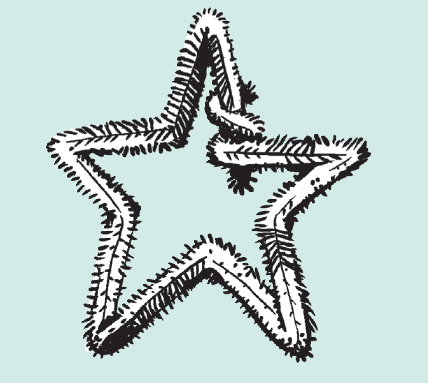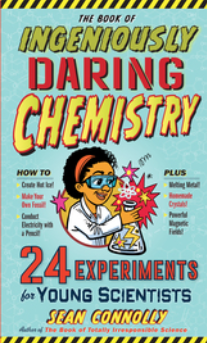A star is boron.
The element boron forms crystals pretty naturally, and in this experiment you can help that process along. And because other elements you’ll read about here are also crystals—or sometimes form them—you’ll have something extremely cool to remember as you learn about their properties. It’s too bad that it’s not so easy to make the crystal form of the next element, carbon. You’ve probably heard of those crystals—they’re called diamonds!
YOU WILL NEED:
♦ Pipe cleaners 
♦ Widemouthed jar (1 pint or 500 ml)
♦ String
♦ Scissors
♦ Pencil
♦ Boiling water
♦ Spoon
♦ Borax (available as 20 Mule Team Borax Laundry Booster in laundry section of grocery stores)
WARNING: Get an adult to pour the boiling water and to handle the borax.
METHOD:
1. Shape the pipe cleaner into a star shape, with the ends meeting to form the fifth pointed side. Make sure the star will fit inside the jar.
2. Tie one end of the string to one of the points of the star-shaped pipe cleaner.
3. Use the scissors to cut the string long enough for the “star” to hang midway down the jar from its mouth.
4. Tie the other end of the string to the pencil.
5. Have an adult pour boiling water into the jar, almost to the top.
6. Add a spoonful of borax to the water and stir until it’s dissolved.
7. Repeat Step 6 until it’s impossible to dissolve all of the borax.
8. Hang the star so the pencil rests on the lid of the jar and the star is suspended in the liquid, not touching the bottom.
9. Leave overnight, preferably in a relatively warm spot (like near a radiator).
10. The next morning, pull out your crystal. You’re a star!
More About The Book of Ingeniously Daring Chemistry:
 From Sean Connolly, the master of messy and dangerous (and therefore extra-fun) science, a collection of more than 20 hands-on experiments that are like an interactive journey through the periodic table of elements.
From Sean Connolly, the master of messy and dangerous (and therefore extra-fun) science, a collection of more than 20 hands-on experiments that are like an interactive journey through the periodic table of elements.
In this introduction to chemistry for STEM-curious kids ages 9 and up, each chapter of The Book of Ingeniously Daring Chemistry focuses on a single element—its properties, how it was discovered, and even its potential danger level. Easy-to-follow experiments help readers put their newfound knowledge into action. All that’s needed is a sense of adventure and some items from around the house.
Make your own fossil with silicon. Use a pinhead and measure 166 feet of string for a mind-boggling insight into how a hydrogen atom is built. Discover oxygen and oxygenation by slicing an apple and seeing what happens an hour later. Harness the power of zinc with a potato clock. And enjoy a special hands-off feature about the “Dirty Dozen”—those nasty elements, from arsenic to plutonium, that can wreak havoc wherever they appear (there are no experiments using these chemicals). Matter really matters, and now you’ll really understand why.
Buy the Book
Amazon | B&N | Indiebound | Workman





No Comments